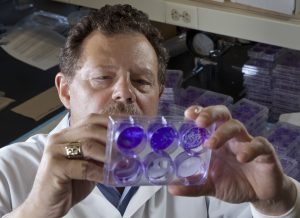
January is National Glaucoma
Awareness Month
Glaucoma is the second leading cause of blindness in the US and is usually associated with increased pressure in the eye. This causes insults to nerve cells (retinal ganglion cells, RGC) resulting in activation of a programmed cell death pathway (apoptosis). The death of the RGCs result in vision loss. Despite a number of therapeutic options for treating glaucoma problems remain. One encouraging approach is gene therapy, or the delivery of a gene to the eye that has a therapeutic effect. Collaborative efforts between several laboratories in our Department are actively exploring gene delivery strategies for glaucoma. One avenue is to deliver genes that increase fluid drainage out of the eye to lower the pressure. We have published proof-of-principle studies showing this is feasible and are continuing to advance this for therapy. The second avenue is to deliver genes that prevent the RGCs from dying by blocking the cell death pathway and we are testing several potential therapeutic genes. We also plan to test combined therapeutic approaches. Delivery of genes to cells is accomplished using a genetically engineered disabled virus (vector) that doesn’t cause disease, but will deliver the therapeutic gene to cells. We have used several different types of viral vectors for this depending on various characteristics of each vector, such as the size of the gene they deliver. The UW laboratories involved are those of Dr. Paul Kaufman, Dr. Robert Nickells, Dr. Donna Peters, Dr. T. Michael Nork and Dr. Curtis Brandt.